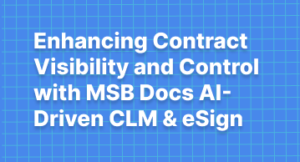Digital Stamping 101: A Game-Changer for Banks
In today’s fast-paced digital age, the banking industry is continually evolving to meet the needs of both customers and regulatory authorities. One of the key advancements that have greatly contributed to the efficiency of banking operations is digital stamping. This innovative technology has revolutionized the way banks handle their documents, resulting in increased efficiency, reduced costs, improved customer experiences, and enhanced security and compliance. In this comprehensive guide, we will delve into the world of digital stamping, exploring its benefits for banks, how it streamlines document workflows, and its future in the banking sector.
What is Digital Stamping?
Digital stamping is a technology-driven process that replaces traditional physical stamps with digital equivalents to authenticate and validate various types of documents. This process involves the use of digital signatures, encryption, and timestamping to ensure the integrity and authenticity of documents. Unlike physical stamps, which can be tampered with or forged, digital stamps provide a higher level of security and reliability.
Benefits of Digital Stamping for Banks
1. Increased Efficiency and Productivity
One of the most significant advantages of digital stamping for banks is the dramatic increase in efficiency and productivity. Traditional document authentication methods often involve manual processes, which can be time-consuming and error-prone. Digital stamping automates this process, reducing the time and effort required to validate documents. This allows bank employees to focus on more value-added tasks, such as serving customers and making informed decisions.
2. Reduced Costs
Digital stamping helps banks cut costs associated with paper-based documentation, physical storage, and manual verification. By eliminating the need for physical stamps, paper documents, and manual handling, banks can significantly reduce operational expenses. Additionally, the streamlined workflow reduces the likelihood of errors, which can lead to costly disputes and regulatory fines.
3. Improved Customer Experience
Banks are increasingly embracing digital solutions to enhance the customer experience, and digital stamping plays a crucial role in this transformation. Customers benefit from faster document processing times, reduced wait times, and a more convenient experience when interacting with their banks. This, in turn, leads to higher customer satisfaction and loyalty.
4. Enhanced Security and Compliance
Security and compliance are paramount in the banking sector. Digital stamping adds an extra layer of security to documents by ensuring their authenticity and integrity. It also helps banks meet regulatory requirements more effectively, reducing the risk of non-compliance and associated penalties. This technology creates a secure audit trail, making it easier to demonstrate compliance to regulators.
How Digital Stamping Can Streamline Banking Document Workflow
1. Loan Disbursal
The loan approval and disbursal process in banks involves extensive documentation, including loan agreements, promissory notes, and collateral documents. Digital stamping simplifies this process by enabling the rapid and secure authentication of these documents. Customers can sign and submit their loan applications digitally, eliminating the need for physical paperwork and in-person visits to the bank. This speeds up the loan approval and disbursal process, allowing customers to access funds more quickly.Loan automation is undergoing a revolution with digital stamping. Discover more about it in this insightful article.
2. Account Opening
Opening a bank account traditionally required customers to visit a branch in person, fill out paper forms, and provide physical identity documents. With digital stamping, banks can offer fully digital onboarding processes. Customers can submit their information and documents online, and these can be digitally stamped for authentication. This not only saves time for customers but also reduces the administrative burden on bank staff.
3. Insurance Policy Issuance
Insurance policies involve a multitude of documents, including policy agreements, coverage details, and beneficiary information. Digital stamping simplifies the issuance of insurance policies by ensuring the authenticity of these documents. Policyholders can access and sign their policies online, and the documents can be digitally stamped to provide proof of coverage. This reduces the paperwork involved in policy issuance and claims processing.
4. Other Banking Processes
Beyond loan disbursal, account opening, and insurance policy issuance, digital stamping can streamline various other banking processes. These include document authentication for investment accounts, mortgage origination, and credit card applications. Any process that involves the exchange of critical documents can benefit from the efficiency and security provided by digital stamping.
The Digital Stamping Process
Understanding how digital stamping works is essential for banks looking to implement this technology. The digital stamping process typically involves the following steps:
1. Document Preparation
The process begins with the preparation of the documents that need to be digitally stamped. These documents are converted into digital format, often through scanning or electronic document creation.
2. Authentication and Verification
Digital stamps are generated and applied to the documents using cryptographic techniques. These stamps include a digital signature and a timestamp, ensuring the authenticity and integrity of the document. Verification processes are employed to confirm the validity of the digital stamp.
3. Document Distribution
Once digitally stamped, the documents can be securely distributed to the relevant parties, such as customers, regulators, or internal departments within the bank. Distribution can occur electronically, reducing the need for physical copies.
4. Audit Trail
A secure audit trail is maintained for each digitally stamped document. This trail records every action taken with the document, from stamping to distribution, creating a comprehensive record for compliance and auditing purposes.
5. Long-Term Archiving
Digital stamped documents are securely archived for long-term storage. This ensures that they can be retrieved and verified as needed, even years after their creation.
Types of Documents That Can Be Digitally Stamped
Digital stamping can be applied to a wide range of banking documents, including but not limited to:
- Loan agreements and promissory notes
- Account opening forms and KYC documents
- Insurance policies and claim forms
- Investment account agreements
- Mortgage documents
- Credit card applications
- Regulatory reports and compliance documents
- Audit and financial statements
The flexibility of digital stamping makes it suitable for virtually any document that requires authentication and verification.
The Future of Digital Stamping in the Banking Sector
As technology continues to advance and customer expectations evolve, the role of digital stamping in the banking sector is likely to expand. Here are some trends and possibilities for the future:
1. Integration with Blockchain
Blockchain technology offers a highly secure and immutable way to store and verify digital transactions and documents. Integrating digital stamping with blockchain could further enhance document security and transparency in banking operations.
2. Artificial Intelligence (AI) Integration
AI can play a crucial role in automating document recognition, verification, and classification. Banks may leverage AI to streamline the digital stamping process, reducing manual intervention and improving accuracy.
3. Mobile-First Solutions
With the increasing use of smartphones and mobile apps in banking, digital stamping solutions will likely become more mobile-friendly. Customers may be able to digitally stamp documents directly from their mobile devices, further simplifying the banking experience.
4. Enhanced Regulatory Compliance
As regulatory requirements continue to evolve, digital stamping solutions will need to adapt to ensure ongoing compliance. This may involve the development of new features and capabilities to meet changing regulatory standards.
Recommendations for Banks on How to Implement Digital Stamping
To successfully implement digital stamping in their operations, banks should consider the following recommendations:
1. Conduct a Needs Assessment
Begin by identifying the specific processes and documents within your bank that could benefit from digital stamping. Understand the regulatory requirements that apply to these processes.
2. Select a Trusted Digital Stamping Solution
Choose a reputable digital stamping solution provider with a track record of security and compliance. Ensure the solution aligns with your bank’s needs and integrates seamlessly with existing systems.
3. Employee Training
Train your employees on how to use the digital stamping solution effectively. This includes understanding the digital stamping process, document handling, and compliance requirements.
4. Customer Education
Educate your customers on the benefits of digital stamping and how to use it. Make the process as user-friendly as possible to encourage adoption.
5. Continuous Monitoring and Improvement
Regularly monitor the performance of your digital stamping solution and gather feedback from employees and customers. Use this information to make continuous improvements and stay ahead of changing regulatory requirements.
MSB Docs eStamp Paper for Banking
For banks looking to implement digital stamping solutions, MSB Docs eStamp Paper is an excellent option. MSB Docs offers a secure and compliant digital stamping platform tailored to the needs of the banking sector. Their solution enables banks to streamline document workflows, enhance security, and improve the customer experience.
In conclusion, digital stamping is a game-changing technology that has the potential to revolutionize the banking industry. Its benefits in terms of efficiency, cost reduction, customer experience, and compliance make it a valuable tool for modern banks. As technology continues to advance, we can expect digital stamping to play an increasingly vital role in the banking sector’s ongoing transformation. By embracing this innovative technology and following best practices for implementation, banks can position themselves for success in the digital age.
Now that you’ve explored ‘Digital Stamping 101: A Game-Changer for Banks,’ are you ready to harness its potential? Take the next step with MSB Docs. Request a demo or book your free trial today.
FAQs
1. What is the difference between digital stamping and electronic signatures in banking?
Digital stamping involves adding a cryptographic stamp to a document for authentication and validation purposes, ensuring its integrity and authenticity. Electronic signatures, on the other hand, focus on obtaining the recipient’s approval or consent on a document. While both enhance document security, they serve different purposes within the banking workflow.
2. Are digitally stamped documents legally recognized in all countries?
The legal recognition of digitally stamped documents varies from country to country. Many countries have adopted digital signature laws and regulations that provide a legal framework for the use of digital stamps. It’s essential for banks to stay informed about the specific legal requirements in their operating regions and ensure compliance.
3. How can digital stamping improve document retrieval and auditing for banks?
Digital stamping creates a secure audit trail for each document, recording every action taken with it, from stamping to distribution. This audit trail simplifies document retrieval and auditing processes for banks. It provides a clear history of document actions, making it easier to demonstrate compliance and track document changes over time.
4. Can digital stamping be integrated with legacy banking systems and software?
Yes, digital stamping solutions can be integrated with legacy banking systems and software. Reputable digital stamping providers often offer APIs (Application Programming Interfaces) that enable seamless integration with existing banking systems. This allows banks to leverage the benefits of digital stamping without overhauling their entire infrastructure.
5. What measures can banks take to ensure the security of digitally stamped documents?
Banks can enhance the security of digitally stamped documents by implementing encryption measures, access controls, and regular security audits. It’s crucial to choose a trusted digital stamping solution provider with a strong focus on security and compliance. Employee training on security best practices and data protection is also essential to safeguard sensitive information in digitally stamped documents.





